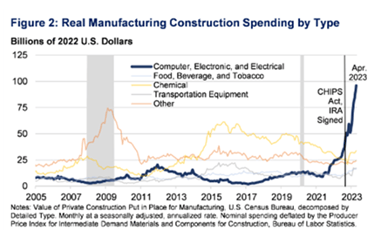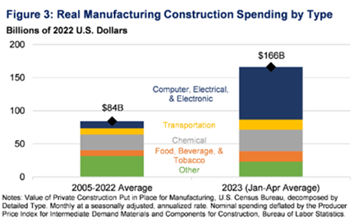
At Crawford, we seek to invest in higher-quality, consistent companies that produce more predictable earnings and dividends. Investing is about the future, which is uncertain, so we seek to improve our chances of success by focusing on companies that display fairly constant demand for their products and services. This tends to eliminate many highly cyclical or overly economically sensitive companies whose businesses may be more volatile in nature.
We have found that a number of companies within the Industrials sector offer us moderate economic sensitivity and exposure to attractive end markets with barriers to entry and sound profitability. These companies typically are utilizing technology to foster automation or improve outcomes and enjoy both niche businesses and high market shares. All of this leads to high visibility, attractive cash flow generation, and above-average quality. As you might expect, the fundamental characteristics of this sector align well with our orientation toward the dividend as an initial indicator of quality.
Related to this sector, one of the strikingly positive aspects of our economy today is the capital spending boom. There has been an increase in construction spend for manufacturing facilities, and this surge appears to be unique to the U.S. In fact, real manufacturing construction spending has doubled since the end of 2021. Manufacturing construction is just one element of a broader increase in U.S. non-residential construction spending. In other words, investments in new factories and on-shoring of manufacturing capacity has not crowded out other types of construction spending.

The recent boom is driven by demand for computer, electronic, and electrical manufacturing, and spending on this kind of construction has nearly quadrupled since the beginning of 2022. This is a newly dominant component of manufacturing in the U.S., and the progress comes in part from a supportive policy environment. The Infrastructure Investment and Jobs Act, Inflation Reduction Act, and CHIPS Act have all provided direct funding and tax incentives for public and private manufacturing construction. Meanwhile, overall spending in other manufacturing segments remains at long-term levels, meaning the new activity is not cannibalizing other investment.
Admittedly, some of the increase in spend is necessary due to rising costs in recent years. But the charts below illustrate that recent spending (relative to historical averages) is not solely due to inflationary pressures.


Much of this recent boom has been semiconductor investments related to the expansion of existing or entirely new chip fabrication plants (fabs). These fabs are located in established and growing semiconductor hubs across ten states. With American “fabless” design firms relying on semiconductor foundries in Taiwan for the majority of their chips, re-shoring of chip fabrication is a significant step toward more secure supply chains amid increasing tensions with China. In addition to fabs, there have been two announced investments in semiconductor equipment facilities. Equipment facilities near fabs allow for increased collaboration between chipmakers and equipment suppliers, giving chipmakers greater access to leading-edge technology and accelerating innovation.
In total, over 70 new semiconductor ecosystem projects have been announced in the U.S., all spurred by the CHIPS Act. This, along with over $250 billion in private investments in 22 states, creates 45,000 new high-quality jobs in the semiconductor ecosystem. This will support hundreds of thousands of additional jobs throughout the broader U.S. economy, as well. While the striking trends present today may cool, the CHIPS Act has fostered an ongoing opportunity for investment in this sector. We are encouraged by this progress and believe it bodes well for Crawford’s investments within the Industrials sector.
Crawford Investment Counsel (“Crawford”) is an independent investment adviser registered under the Investment Advisers Act of 1940, as amended. Registration does not imply a certain level of skill or training. More information about Crawford, including our investment strategies, fees, and objectives, can be found in our Form ADV Part 2 and/or Form CRS, which is available upon request.
The opinions expressed are those of Crawford. The opinions referenced are as of the date of the commentary and are subject to change, without notice, due to changes in the market or economic conditions and may not necessarily come to pass. Crawford reserves the right to modify its current investment strategies and techniques based on changing market dynamics or client needs.
Material presented has been derived from sources considered to be reliable, but the accuracy and completeness cannot be guaranteed.
CRA-2403-2
The opinions expressed herein are those of Crawford Investment Counsel and are subject to change without notice. This material is not financial advice or an offer to sell any product. Forward-looking statements cannot be guaranteed. This document may contain certain information that constitutes “forward-looking statements” which can be identified by the use of forward-looking terminology such as “may,” “expect,” “will,” “hope,” “forecast,” “intend,” “target,” “believe,” and/or comparable terminology. No assurance, representation, or warranty is made by any person that any of Crawford’s assumptions, expectations, objectives, and/or goals will be achieved. Nothing contained in this document may be relied upon as a guarantee, promise, assurance, or representation as to the future. Crawford Investment Counsel is an investment adviser registered with the U.S. Securities and Exchange Commission. Registration does not imply a certain level of skill or training.
These Perspectives on Sector Specific
600 Galleria Parkway
Suite 1650
Atlanta, Georgia 30339
Main: 770.859.0045
Fax: 770.859.0049
Email: info@crawfordinvestment.com

Copyright © 2025 | Crawford Investment Counsel, Inc. | All Rights Reserved.
Crawford Investment Counsel, Inc. (“Crawford”) is an independent investment adviser registered under the Investment Advisers Act of 1940, as amended. Registration does not imply a certain level of skill or training. More information about Crawford Investment Counsel, including our investment strategies, fees and objectives, can be found in our Form ADV Part 2A and our Form CRS.
Web Site Development by: Goodwood Consulting
You are now leaving the Crawford Investment Counsel website and accessing the
Crawford Investment Funds website.
You are now leaving theCrawford Investment Funds website
and accessing the Crawford Investment Counsel website.
To help us personalize the site to your needs,
please select one of the following that best describes you.
You are now entering the area of the Crawford Investment Counsel website
that is for Consultant & Investment Professional Use Only.
You are now leaving the Crawford Investment Funds website and accessing the
Ultimus Fund Solutions website.
You are now entering the area of the Crawford Investment Counsel website
that is for Endowment & Foundation Use Only.